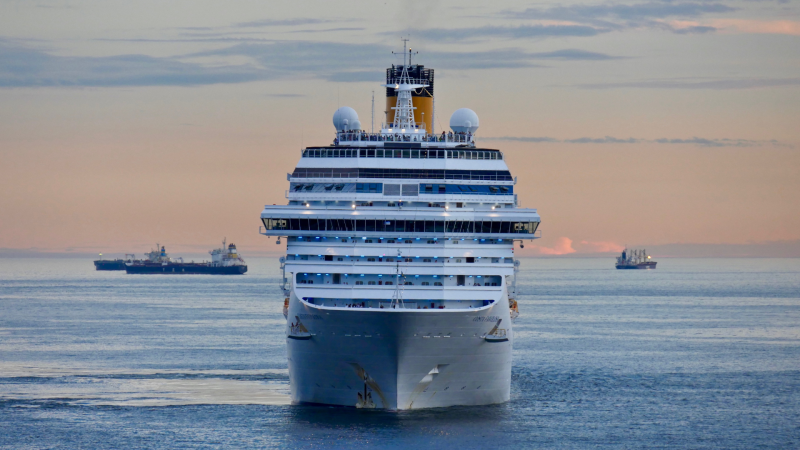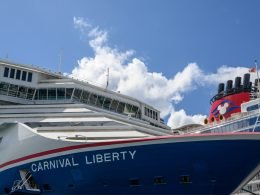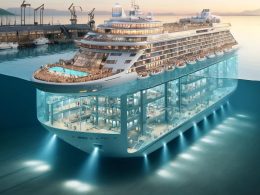Before setting sail, getting to know some essential terms is a good idea. If not, you could find yourself confused. Knowing terms, like embarkation port, is imperative to understand as they will majorly impact your trip. We’ll give you the meaning of embarkation and more.
We want to help you to know and use the lingo while cruising. Keep reading if you’re new to cruising or want to enhance your vocabulary.
Today, we’ll explain some of the most common cruising terms and what they mean. So climb aboard, and let’s get started!
What Does Embarkation Mean?
The term embarkation means the process of boarding a ship, aircraft, or other mode of transportation. Typically, it describes the start of a journey or voyage. This is when passengers, crew, and cargo board the vehicle. The process usually occurs at a particular place like a port, airport, or terminal.

What Is an Embarkation Port?
An embarkation port is the initial port of departure for a cruise ship. This is where you’ll start your cruise or other adventure. Passengers will typically complete the onboarding process at their embarkation port, including security, document verification, and passing baggage to the cruise line.
Embarkation ports have facilities similar to airports capable of handling large numbers of guests. They’re typically very efficient and have terminals, security checkpoints, baggage handling, and parking areas to make the process as smooth as possible.
What Is the Difference Between Embarkation and Disembarkation Port?
For closed-loop closes, the embarkation and disembarkation port is the same. These are cruises that start and end at the same location. However, one-way cruises use different ports for embarkation and disembarkation.
As we mentioned, the embarkation port is where the adventure starts. As you might assume, the disembarkation port is where the experience concludes. Passengers will leave the ship, pass through customs and immigration procedures, and reach the final destination.
Other Cruising Terms to Know
Besides embarkation and disembarkation, there are many other terms you should know. Awareness of these terms and their meanings can help ensure a smooth and safe cruising experience.
Cruise Director
The term “cruise director” refers to the crew member responsible for entertainment, activities, and guest services. You’ll frequently hear and see them around the ship, especially at large events.
Part of their job is coordinating entertainment like live shows, performances, games, contests, and themed parties. They’ll often make announcements and manage the staff that oversees the activities onboard the ship.
Overall, the cruise director is responsible for creating a fun, enjoyable, and exciting atmosphere onboard the ship. The cruise line wants everyone to have a great time, and the cruise director is the primary means of accomplishing this goal.

Muster Drill
A muster drill is the safety drill that occurs before a cruise ship can leave port. Traditionally, this required passengers to dawn their life vests and meet with crew and passengers at their assigned spots on the boat. The drill would last until all passengers and crew were in their designated stations.
Luckily, technology makes it easier for cruise lines to complete this vital safety drill. Some cruise lines allow passengers to watch, listen, and read essential information on their phones. They can then check in with the crew at their assigned spot and explore the ship. It’s much faster, less intrusive, and more efficient than previous drills.
HOT TIP
Be sure to read up on whether or not Cruise Ships still do Muster Drills before booking your next trip!
Port of Call
“Port of call” is a term used to describe the schedule stops for a cruise ship’s itinerary. These are locations where passengers can get off the boat and explore or participate in shore excursions. The amount of time spent at each port of call varies based on the itinerary. It could be anywhere from a few hours to an entire day.
Some cruise lines own private islands and will stop for the day at the island. Guests can get off (or stay on the ship) at a port of call. Whether you get off at a port of call or not is entirely up to you.
Shore Excursion
Many guests sign up for shore excursions when at a port of call. These are organized activities that allow passengers to explore and experience the area. They can be a quick and easy way to get a taste of a destination’s culture, attractions, and activities.
You can sign up for shore excursions through the cruise line or directly with a tour operator. However, it is essential to know that cruise lines typically weed out any potential excursions that don’t provide a premium value. Unfortunately, this means you’re likely going to pay a premium.
When booking shore excursions, you must consider how long you’ll be in a port of call. If you book through the cruise line, they’ll ensure you make it back in time to avoid getting left behind. However, if you book a shore excursion, you’ll want to consider how long it will take.
Some could require an hour or more drive from the port, and any unplanned events could cause issues for returning on time. Unfortunately, the ship will leave without you, and you’ll be responsible for paying for and arranging transport to meet back up with the boat.

Tender
We’re not referring to the dating website, but a small boat. These vessels transport passengers from a cruise ship to a port of call. The cruise ship drops anchor or sits safely offshore in deeper waters. This is common for areas where the water is shallow, or no dock can accommodate a boat.
It’s best to think of a tender as a water taxi. Passengers climb aboard these tiny boats, and the crew transports them directly to the port of call. From there, they can explore the port, go on shore excursions, and so much more.
When finished at the port of call, passengers return to the cruise ship via the tenders. During peak times, it could require a significant wait. Letting others go first can be a good idea if you’re not in a hurry. Otherwise, you’ll likely find yourself waiting in a long line to board the tender.
Stateroom
A stateroom is a term used to describe the room where passengers stay during their cruise. These function like hotel rooms as they come in various shapes and sizes. You’ll find staterooms on the interior of a ship with no windows. Additionally, you’ll find some on the outside with windows and balconies overlooking the ocean.
When selecting your stateroom, you must consider your budget, desired view, and what level of comfort you expect. If you want a premium luxury experience, you’ll want to consider a suite. However, you’ll need to pay a premium price tag. If you wish to get on the ship and don’t need a window, an interior room can be a fantastic and budget-friendly option.
Cruise Ship Itinerary
The cruise ship itinerary is the detailed plan that lists all the ports of call, destinations, activities, and schedules for the cruise. You’ll typically find a day-by-day overview of what will occur while sailing. This can allow you to plan your time and when you’ll see shows or other entertainment options.
These documents will typically list each port of call, the short excursions available at the port of call, and a day-to-day schedule of everything taking place on the ship. You’ll want to closely examine the shows, performances, and games, as they may only be offered once throughout the cruise. If there’s a specific activity you want to enjoy, you’ll want to plan accordingly.
Luggage Tag
A luggage tag is a label given to passengers by the cruise line that gets attached to luggage. It helps identify the bag’s owner and ensure it gets delivered to the right stateroom or its owner at the end of the cruise.
You’ll typically find the passenger’s name, contact information, and home address on the tag. This information helps ensure officials can contact the owner if their luggage becomes lost or misplaced during delivery.
When attaching a luggage tag to your baggage, you want to fasten it securely. You can purchase clear plastic luggage tag holders. This helps ensure your luggage tag is evident on your bags and prevents it from accidentally falling off during transit.
- Quick Identification: Easily spot your bags with our durable cruise bag tags for luggage; waterproof materials and steel loops ensure your luggage stays safe and easy to find during travel
- Essential for Travelers: Includes 4 cruise necessities tags for major cruise line paperwork; designed to protect and organize documents, making your cruise experience smoother
- Durable Construction: These luggage tags that stand out are made from weather-resistant materials, providing security for your documents while ensuring your luggage is easily identifiable
- Fits Major Cruise Lines: Cruise bag tags measure 6.5 x 2.5 inches, fitting Royal Caribbean, Disney, and Carnival cruise paperwork; zip-top closure keeps documents safe from moisture
- Secure and Strong: Stainless steel loops keep these luggage tags securely attached to your suitcase, ensuring they stay in place throughout your cruise journey for easy identification
Onboard Credit
The term onboard credit refers to a monetary credit given to cruise passengers. You can use these funds onboard the ship for a variety of expenses. These are often a part of promotions, packages, or even loyalty programs. If you book through a travel agent, they may even offer you onboard credit.
How you spend your onboard credit is entirely up to you. You can use it for dining, beverages, shore excursions, purchase in the gift shop, or even in the casino. Since it’s tied to your onboard key card, you can typically spend it anywhere you would use it to pay.
Midship
The term “midship” refers to the middle section of the ship. You’ll typically find cabins, lounges, restaurants, and other popular amenities here. The cruise line recognizes these are some of the most popular attractions and amenities and wants them to be as convenient as possible.
Additionally, the midship section of a cruise ship is the most stable. These facilities typically are closer to the ship’s center of gravity, which can help those who struggle with motion sickness. Since there are multiple levels on a cruise ship, there are numerous levels when it comes to the midship of a cruise ship.

Know Your Cruise Lingo Before You Set Sail
Now that you know your cruise terminology, you can practice before setting sail. While you can learn many more terms, this is a great place to start. The more you set sail, the more you’ll hear new terms. If you need help figuring them out, let us know. We’re happy to help so you and anyone cruising with you can have an incredible adventure at sea.
If You Want the Latest Travel News, Join Our Mailing List
Don’t rely on biased RV industry news sources to keep you informed. Stick with Nomadic News. We publish articles and breaking stories that matter to you every weekday.
Last update on 2025-06-19 / Affiliate links / Images from Amazon Product Advertising API











